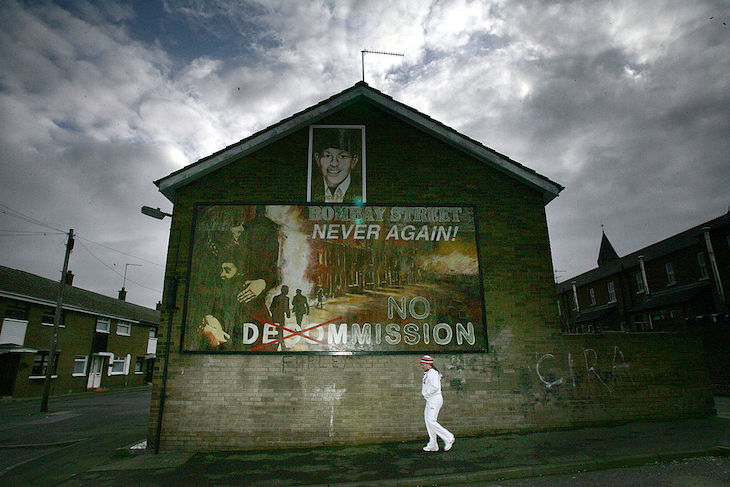‘As if we didn’t have enough to argue about!’ exclaimed the gentleman in front. We were standing just off a busy road adjacent to a looming wall. The road wasn’t any road, and the wall wasn’t any wall. It was Shankill Road, and this was one of Belfast’s infamous peace walls.
The man wasn’t picking a fight. He was referring to West Belfast’s increasingly prevalent references to the war in Gaza. Peace walls have adorned murals of Northern Irish paramilitaries for decades. Now, there are a growing number of references to fighting in the Middle East, with Belfast’s Protestant and Catholic communities divided on the issue with sad predictability. Falls Road is rich in Palestinian flags; the Star of David flies high along Shankill Road.
Back in England, most people are not aware these walls still exist. Eyebrows are raised further still when I mentioned Belfast’s ‘Checkpoint Charlie’, the peace gates that close each evening to prevent travel between predominantly Protestant and Catholic areas.
‘Hadn’t the Good Friday Agreement put an end to all that?’ a friend asked, scrolling through photos I’d taken. Many assume the Good Friday Agreement (GFA) – which was signed in April 1998 – was a silver bullet that solved all of Northern Ireland’s problems. At a recent St Patrick’s Day reception in Downing Street, Keir Starmer stated the GFA was the greatest achievement of a Labour government in his lifetime.
Hilary Benn, the Northern Ireland Secretary, feels similarly. ‘The Good Friday Agreement’, he told me, ‘and the peace and prosperity it has brought to Northern Ireland, is in my view the greatest achievement of the last Labour government…’
Benn went further, calling it ‘a triumph of political courage and compromise, over sectarianism and intransigence.’ There is no denying its impact. The Troubles, which claimed thousands of lives, came to an end. A new political settlement was forged.
Even having a St Patrick’s Day reception at Downing Street was once unthinkable. Pre-GFA, such a prospect would be about as likely as the late-Queen popping into a Sinn Féin fundraiser.
For the most part, the GFA has ended the bloody violence that plagued Ireland for centuries. Shopping centres no longer need metal detectors. People can drink the beer of their choice without fearing gunmen will storm the bar.
The Troubles had defined the lives of generations. For having the ‘wrong’ number plate, my grandmother would have rocks thrown at her car daily on her way to work as a nurse in Belfast. Because of the GFA, a cohort of young people in Northern Ireland know nothing but the relative peace it has afforded them.
In Bittles Bar — a wedge-shaped pub in central Belfast, its walls lined with portraits of Irish republican figures — I spoke to two young men: one Catholic, one Protestant. They laughed when I asked if their differing backgrounds ever caused them trouble when they were out together. ‘No one our age cares about that,’ one told me. ‘It’s mostly the old boys living in the past that bang on about The Troubles – we’ve moved on.’
But that’s not the full picture. Brandon Lewis, a former Northern Ireland Secretary, said that while huge progress has been made, much of Northern Irish society remains quietly segregated. One of the challenges, he suggested, was ‘that too much of Northern Ireland is still living in either Catholic or Protestant areas.’ Even if residents aren’t churchgoers, ‘they still often live in areas that are considered to be one thing or the other.’
Peace walls are not only physical barriers, but flashpoints for unrest. On days of historic significance, such as The Twelfth (the anniversary of the Battle of the Boyne in July), loyalists have been known to burn Irish tricolours on bonfires in view of Catholic homes. Likewise, Irish nationalists have set fire to Union flags and poppy wreaths. Even if the violence has been consigned to history, the symbols of defiance still blaze.
The walls ensure that daily life is still shaped by the division of which side you’re on. When the gates close each night, it’s a clear sign of the failure to build a Northern Ireland free of sectarianism.
In the shadow of Divis Tower, I met a man who wants to change that. Rob McClenaghan, a community leader in West Belfast, was once deeply embedded in the conflict. He served time in prison for planting bombs as a member of the IRA.
Today, he works with both Catholics and Protestants to campaign for an unfulfilled promise of the Northern Irish executive: the gradual removal of the peace walls. He focuses on practical, incremental steps such as extending gate opening time. His simple but ambitious goal is to make the walls obsolete.
The GFA deserves to be celebrated. But pretending it solved everything in Northern Ireland risks complacency. It overlooks the persisting divisions, of which the walls are the most visible sign. Their continued presence is a reminder that, while the guns have fallen silent, the work of reconciliation is incomplete.
If this government wants to honour the Agreement’s true spirit, it must do more than mark anniversaries. It must support, from the ground up, the slow, unglamorous work of healing: one gate, one conversation and one step at a time.







Comments